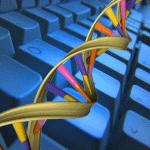Bioinformatics
|
17 november 2014 12:36:21 |
| The chloroplast outer envelope protein P39 in Arabidopsis thaliana belongs to the Omp85 protein family (Proteins: Structure, Function, and Bioinformatics) |
|
Tweet Proteins of the Omp85 family chaperone the membrane insertion of ?-barrel-shaped outer membrane proteins in bacteria, mitochondria and probably chloroplasts and facilitate the transfer of nuclear-encoded cytosolically synthesized preproteins across the outer envelope of chloroplasts. This protein family is characterized by N-terminal polypeptide transport-associated (POTRA) domains and a C-terminal membrane-embedded ?-barrel. We have investigated a recently identified Omp85 family member of A. thaliana annotated as P39. We show by in vitro and in vivo experiments that P39 is localized in chloroplasts. The electrophysiological properties of P39 are consistent with those of other Omp85 family members confirming the sequence based assignment of P39 to this family. Bioinformatic analysis showed that P39 lacks any POTRA domain, while a complete 16 stranded ?-barrel including the highly conserved L6 loop is proposed. The electrophysiological properties are most comparable to Toc75-V, which is consistent with the phylogenetic clustering of P39 in the Toc75-V rather than the Toc75-III branch of the Omp85 family tree. Taken together P39 forms a pore with Omp85 family protein characteristics. The bioinformatic comparison of the pore region of Toc75-III, Toc75-V and P39 shows distinctions of the barrel region most likely related to function. This article is protected by copyright. All rights reserved. |
| 240 viewsCategory: Biochemistry, Bioinformatics |
 iATTRACT: Simultaneous global and local interface optimization for protein-protein docking refinement (Proteins: Structure, Function, and Bioinformatics) iATTRACT: Simultaneous global and local interface optimization for protein-protein docking refinement (Proteins: Structure, Function, and Bioinformatics)Frequent side chain methyl carbon-oxygen hydrogen bonding in proteins revealed by computational and stereochemical analysis of neutron structures (Proteins: Structure, Function, and Bioinformatics) 
|
| blog comments powered by Disqus |
MyJournals.org
The latest issues of all your favorite science journals on one page
The latest issues of all your favorite science journals on one page



